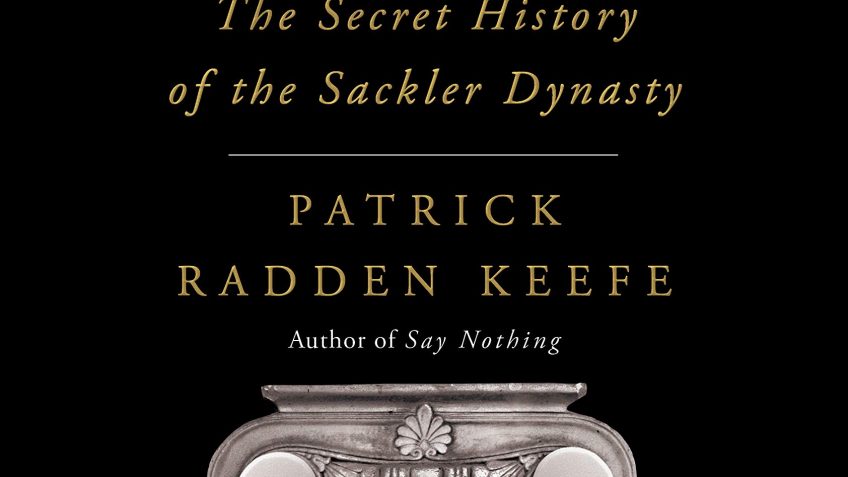“Originally, there had been three Sackler brothers, [Kathe Sackler explained]. Arthur, Mortimer, and Raymond. Mortimer was Kathe’s father. All three of them were doctors, but the Sackler brothers were ‘very entrepreneurial,’ she continued. The saga of their lives and the dynasty they would establish was also the story of a century of American capitalism. The three brothers had purchased Purdue Frederick back in the 1950s. ‘It was a much smaller company, originally,’ Kathe said. ‘It was a small family business…’”
– Patrick Raden Keefe, Empire of Pain: The Secret History of the Sackler Dynasty
Despite being overshadowed by the coronavirus pandemic, the opioid epidemic remains one of the largest public health emergencies in recent American history. Since 1999, almost 500,000 people have died from overdoses involving an opioid, with another couple million people classifiable as having an abuse disorder. Along with the human carnage comes economic and societal costs that are hard to quantify, but some have reckoned as high as $2 trillion.
The Sackler family – owners of Purdue Pharma, makers of OxyContin – did not create the crisis on their own, and cannot be apportioned all the blame. Many factors have to move simultaneously for a catastrophe of this magnitude. Nevertheless, they deserve to shoulder a huge portion of the responsibility, as the creation of their wonder drug, its aggressive marketing, and its ridiculous ubiquity has established it as a major catalyst in the calamity.
Throughout most of Purdue Pharma’s lifespan, the owners did their best to keep their names out of the limelight. Whenever a Sackler was mentioned, it was typically in connection with large charitable gifts to medical schools, art galleries, and museums, for which they demanded and received due credit.
In Empire of Pain, journalist Patrick Raden Keefe fixes to change all that. By the time you reach the last page, if you ever hear the name Sackler, you will think of only two things.
***
Empire of Pain is an instant classic. It is beautifully written, marvelously structured, deeply reported (with Keefe’s source notes presented like a legal brief, to ward off the threatened litigation he faced), and passionately argued. Beginning in 1913 – with the birth of Arthur Sackler – and ending in the present day, with Purdue Pharma in bankruptcy and COVID-19 raging, Empire of Pain has the sweep and scope of a great epic, and more than a few elements of a tragedy.
While there are some very good books on this subject – to Keefe’s credit he mentions these titles, and makes no pretense to “breaking” this story – Empire of Pain towers over all others, not just in terms of sheer ambition, but in terms of near-perfect execution.
***
Maybe the most important thing to know going into Empire of Pain is that it is not solely – or even mostly – focused on the United States’ ongoing addiction to prescription painkillers and their street-drug equivalents (namely heroin). Instead, it is divided into three rather different sections. Sometimes the different parts inform each other, sometimes they do not. In any event, they all hold together beautifully.
***
The first third of Empire of Pane is biographical, focusing on Arthur Sackler and – to a much lesser extent – his brothers Raymond and Mortimer. It closely follows Arthur’s rise as the son of a middle-class grocer to become a fantastically wealthy doctor, adman, and business owner. Keefe has done something extremely rare, which is to create a characterization that is so vivid and tactile that you feel you are with the person, that you understand what they’d think or say in a given situation. And he does it all in just over a hundred pages. It is a testament to how well Empire of Pain worked for me that even a chapter on ancient Chinese furniture – which became one of Arthur’s abiding passions – entirely held my interest.
Arthur played a huge role in the marketing of Thorazine and Valium, helping to create the idea that prescription drugs were just like every other American commodity, something to be mercilessly marketed and sold to as many people as possible. Yet Arthur is not presented as some embodiment of evil. He was an extremely hardworking man who began his career as a psychiatrist, a field of medicine that even today is slighted in comparison to other disciplines.
Despite the amount of space given to Arthur, his role in the oncoming epidemic is contextual only. He may have created a blueprint for selling medications to patients who did not necessarily need them – and who might be harmed by them – but he was dead by the time OxyContin hit the bloodstreams of the body public.
***
Empire of Pain’s middle portion follows the rise of Purdue Pharma. This company, spun off from Purdue Frederick (which Arthur purchased, and which made every day over-the-counter medicines, such as Senokot laxatives), controlled a small drug company in the United Kingdom that had created a timed release morphine pill called MS Contin. Since morphine is addictive, and had been used mainly for end-of-life pain management, such a pill seemed to have limited application. The “genius” of Purdue Pharma was to rebrand MS Contin as something that could be used to treat all manner of pain. Later, Purdue Pharma did the same thing with the much more powerful OxyContin, selling it – with the FDA’s questionable approval – as a safe painkiller that could be widely deployed to fight the “pain epidemic” purportedly afflicting the nation.
The main character Keefe follows through this section is micromanager extraordinaire Richard Sackler. A physician himself, Richard’s peculiar talent was recognizing that he had stumbled on a single billion-dollar idea, which he thereafter clung to with remorseless intensity.
While Richard is always around, Keefe starts to broaden his story, moving away from the Sackler’s to encompass many other topics, including the creation of both MS Contin and OxyContin, the history of opium, the Napp Technologies plant explosion, and the tactics used by the Purdue Pharma salesforce to achieve $35 billion in Oxy sales over two decades. Though Keefe sometimes veers off the trail –for example, Napp Technologies was owned by the Sacklers, but he doesn’t connect them to the negligent day-to-day operations that led to the disaster – the narrative is still absolutely engrossing.
***
The final third of Empire of Pain deals with the fallout. Here, the storyline becomes more diffuse, as Keefe no longer follows any of the Sackler family members with the previous intimacy he showed for Arthur and Richard. Instead, he expands his coverage even further, to include federal prosecutors, state attorney generals, journalists, and activists who tried to bring down the Sackler dynasty. With effortless dexterity, Keefe is able to navigate the numerous lawsuits in a way that is understandable, accurate, and dramatically compelling. He also follows the wave of un-naming ceremonies, as all the institutions that gladly took Sackler money in the past, erased the Sackler name from those gifts (without, it seems, paying the money back, which is a quintessential modern example of confusing the signaling of virtue with being virtuous).
Keefe is not able to give us the final word, as the wheel is still in spin (a judge recently rejected a global bankruptcy settlement for Purdue Pharma). Whatever happens, nothing is going to bring back Purdue Pharma. We are left now to deal with its devastation.
***
Empire of Pain is about many things, which is why it is so magnificent. Chiefly, though, it is a morality tale about the corporate erosion of social institutions. A corporation is a legal fiction, a business entity that takes on the character of an immortal person. It is a made-up thing that does not exist in nature; it is not a mountain or a tree or a banana or a human being. Despite this, it is treated by the law as some immutable universal truth. In the 21st century, a corporation has many of the important constitutional rights of a flesh-and-blood citizen, but none of the ethical responsibility. A corporation, after all, exists only to enrich its shareholders. More importantly, a corporation does not face any consequences. If you or I break the law, we go to jail. But you can’t put an orange jumpsuit on a corporation. In the case of the Sacklers, the corporate form allowed them to make billions of dollars, to take that money out of the corporation like an ATM (to the tune of $10 billion in disbursements), and then leave the empty husk of Purdue Pharma to be picked over by creditors.
The corporate veil will shield the Sacklers from any criminal exposure, and will most likely shield the vast majority of their fortune, which is sloshing away in offshore accounts. Empire of Pain raises important questions about who the law is supposed to protect. Legal genuflection to the corporate form is not, obviously, a new condition, and it did not start with Purdue Pharma. Sometimes, though, it takes an infuriating and appalling situation to change the status quo, and maybe this can be the beginning of the end.
But probably not.
***
This isn’t a knock on Keefe or Empire of Pain (who is upfront about the type of story he is trying to tell), but the opioid epidemic the Sacklers fueled is a bit abstracted here. There are no portraits of shuttered factories, dying towns, or desperate men and women looking for an out; there are no shooting galleries, drug dealers, swollen jails or overtaxed rehabilitation clinics; there is a chasm between us and the broken lives and the naloxone advertisements at the bus stop and the addict dying alone with his brain so addled it’s not monitoring carbon dioxide buildup or sending messages to his diaphragm.
In short, this is a strangely sterile and sanitized look at the ravages of OxyContin and its ilk, viewed from the same distance as the Sacklers viewed it. To that end, I’d recommend further reading, such as Beth Macy’s Dopesick. Other angles of the epidemic are also ignored, in the interest of space and coherence. For instance, Keefe admittedly does not attempt to deal with the complicated issue of chronic pain management, an issue that is going to get a lot harder as opioids are forced into retreat.
Ultimately, the Sackler family will be just fine. And by fine, of course, I mean that they will continue to sit on a pile of cash big enough to make Scrooge McDuck blush; they will continue to have multiple mansions in the best parts of the globe; they will continue to have access to private planes and private beaches and massive yachts and exclusive resorts; they will eat lobsters stuffed with steak and truffles and diamonds; they will spend more in a month than most people make in a year or a decade or a lifetime. None of them will ever have to do a day’s worth of actual labor. Their descendants for untold generations into the future will accept the dividends of this wealth as something they have earned and to which they are entitled. For all of this, they will continue to see themselves as the real victims.
The only thing they have really lost is their good name. This was an obsession that started with Arthur Sackler, and that has continued to be of utmost importance to every wing of the family. Every time they gave a dime, they wanted a sign saying “Sackler.” They wanted their name to live forever.
Now it will. No one will ever forget this family, but not for the reasons they intended. Forevermore, the name of Sackler will mean greed. Forevermore, the name of Sackler will mean death.


 By
By 








